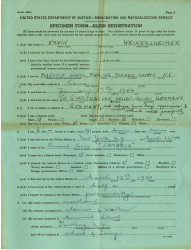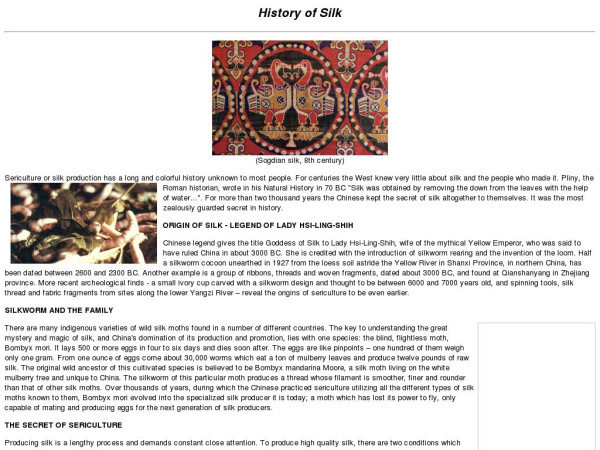ufn44 uln44
Social Studies teacher
Pittsburgh CAPA
Middle School (13 to 15 years old), High School (16 to 18 years old)
Teacher/Educator
Language Arts And English, Civics, Literature, Cultures, Economics, Social Studies, Geography, Writing, US History, Arts, Other
I'm a history-lover, art fan, and bookworm. I taught high school history (U.S. History and World Religions) for ten years in North Carolina, teach currently in Pittsburgh, PA, and am working to help teachers make the most of this new resource!
ufn44 uln44's collections
Signs of the Times
This collection includes sixteen signs and posted notices from across the Smithsonian's collections. Use your history detective skills to figure out what you can about the sign--but don't look at the information tab! Can you determine the context for each sign, matching it to a place and decade in United States history? Consider who it might have been aimed at and for what purpose it was used. Be as specific as possible. The first resource models a historian's thinking and questioning process for students to mimic with other signs in the collection. Answers are listed on the last resource.
Tags: historical thinking, questions, review activity
 ufn44 uln44
ufn44 uln44
17
Tools for Meditation
Are you interested in meditation? This topical collection includes a variety of tools for meditation, including mandalas, music, prayer beads, labyrinths, and a video of a guided meditation and pranayama (breathing) practice. Web links to additional background information are embedded throughout.
 ufn44 uln44
ufn44 uln44
16
Take Action on Air Pollution
<p>This collection of resources invites students to examine how societies have been convinced to take action regarding air pollution over time, and to craft their own persuasive message regarding pollution. Students will identify several different means of compelling individuals and groups to change their behavior in order to benefit the environment. They will then evaluate the effectiveness of those strategies. Finally, they will create their own message convincing others to take steps towards improving the environment. </p><p>Tags: smoke control, smog, pollution, environmentalism, earth day, advertising, persuasive writing, ad campaign</p>
 ufn44 uln44
ufn44 uln44
9
Weikers Family Collection Class Warm-Up
<p>This is a single document with hot spots and questions used to model primary source analysis for a sixth grade class. It is drawn from a collection of archival records and photographs documenting the Weikers family's experience in Nazi Germany and their persistent efforts to seek asylum in the United States. You can find the full collection here:</p><p>https://learninglab.si.edu/collections/weikers-family-collection/zGJCDjyWqouEufnb</p><p>Questions to consider are:</p><p>a. Who are the Weikers?</p><p>b. Where did they live?</p><p>c. When did they live? What can they tell us about this time in history?</p><p>d. How were they affected by Nazi Germany?</p><p>e. What did they feel about the Nazis?</p><p>Tags: Nazi Germany, Holocaust era, primary sources, Pittsburgh</p>
 ufn44 uln44
ufn44 uln44
2
The Black Power Movement
<p>Teaching about the Black Power Movement can be challenging, but has rich rewards. Misconceptions about the Black Power Movement abound, but the ability to contrast their strategies and aims with the earlier Civil Rights Movement allows Social Studies teachers to discuss the complex ways that social movements evolve, change, and respond to the times. In addition, a study of the Black Power Movement helps give context for a broader study of the economic and political shifts in the 1970s and 1980s and the rise of identity politics. This teaching collection includes a variety of resources that could be used to teach about the Black Power Movement, organized into sections for:</p><p>-People in the Movement</p><p>-Goals and Strategies of the Movement</p><p>-Teaching Activities</p><p>General guiding questions for this collection include:</p><p>-What were the distinct problems that the Black Power Movement tried to address? Do they remain today?</p><p>-What were the strategies of the Black Power Movement? Do you agree or disagree with these? </p><p>-Why and how do social movements develop and evolve? </p><p>-What defines a successful social movement? Was the Black Power Movement successful?</p><p>- Can a social movement survive beyond the demise of its leadership?</p><p>-What is the role of the arts in promoting the ideals of social movements?</p><p>This is a work-in-progress based on the digitized materials within the Smithsonian Learning Lab's collection--it is not meant to be wholly definitive or authoritative.<br /></p>
 ufn44 uln44
ufn44 uln44
31
Attention-grabbing headlines don't always tell truth!
<p><strong>Attention-grabbing headlines don't always tell truth!</strong></p><p><strong>Pictures are powerful, sometimes edited!</strong></p><p><strong>Twitter doesn't tell whole story.</strong></p><p><br /></p><p>In the era of "fake news" and information overload, we all need to become better readers of the words and pictures that are used to explain what is going on in the world around us. In this activity, students and teachers will consider:</p><p><strong>How<span></span></strong><strong> can the choice of image or words convey different messages about current events? How do journalists and editors shape the news through their choices?</strong><br /></p><p>This student activity asks students to look at several images of young people resisting a law or recent event. Their task is to write two different headlines for that image designed to appeal to different audiences. They will also be asked to research the context for the image and to consider how that might impact their headlines. </p><p>The goals of this lesson are to:</p><ul><li>explore image and word choice as news drivers (factors that make items newsworthy or appealing to readers)</li><li>determine how journalists and editors shape the news through their choices</li><li>encourage news literacy and a critical reading of headlines and photojournalism in the future. </li></ul>
 ufn44 uln44
ufn44 uln44
15
Forced Removal during Apartheid: Examining Historic Photographs
<p><em>How did apartheid affect the lives of blacks living in Johannesburg in the late 1940s and early 1950s? What was the purpose of forced removal?</em></p><p>This student activity uses the examination of historical photographs as an entry point to learning about the forced removal of blacks from urban areas to townships & homelands under apartheid in South Africa. The images here are all from Sophiatown and Soweto. What details emerge about the life changes that resulted from being moved? What questions remain?</p>
 ufn44 uln44
ufn44 uln44
19
Practice Reading Portraits--Black History Month
<p>This collection was created for a brief warm-up activity where students practiced analyzing portraits of recognizable figures as a group, prior to working on their own portrait analysis. Portraits of Muhammad Ali, Serena Williams, Rosa Parks, and Booker T. Washington are included and they vary in detail and medium. </p><p>The last resource, a PDF file, is a teacher's guide created by the National Portrait Gallery. Teachers should lead discussion about the portraits using suggested questions in the guide, and then let students search for a portrait of someone of their own choosing to analyze.</p><p>tags: civil rights, sports, tennis, boxing, African-American, black history, analysis, comparison</p>
 ufn44 uln44
ufn44 uln44
6
Leonidas at Thermopylae
<p>This 2-resource collection is intended to introduce students to the Battle of Thermopylae through an artistic interpretation and a map and graph rendering. It could be used as a short bellringer, warm-up, or homework activity prior to in-class discussion of the battle.</p><p>Tags: Sparta, Greece, Greek, Persia, Xerxes</p>
 ufn44 uln44
ufn44 uln44
4
The Art of Writing and Calligraphy
This collection includes a variety of resources representing styles of writing from around the world. It encourages viewers to consider writing not only for its ability to communicate through letters and symbols, but also for its artistic value. The collection includes a video on Sumerian writing, a website on African writing systems and art, and artifacts that are examples of the writing of East Asian, Arabic, Cherokee, Hebrew, and Modern European alphabets. In addition, a few tools used for writing are included. There is some background material on each type of writing as you read through the collection.
Questions for classroom discussion and research might include:
-What is the purpose of writing? Why use hand-writing or calligraphy instead of using a computer?
-How do alphabets differ?
-How can a style of calligraphy (or font change) the interpretation of a written work?
 ufn44 uln44
ufn44 uln44
29
Numbers
<p>This collection is an example of how the Learning Lab could be used to create number or alphabet books for younger students. Students can search for the numbers and letters represented in the art, sculpture, and artifacts that exist throughout the Learning Lab. </p><p>Alternatively, students could be given a specific theme (animals, for example) and be tasked to find images representing the theme for each letter or number. Annotation (notebook tabs) can be used to include additional text or explanations. Quiz questions could be used to ask "how many ________ are in this image?".</p><p>Have fun!</p><p>Tags: reading, books, alphabet, numbers, counting, math, young learners, early childhood</p>
 ufn44 uln44
ufn44 uln44
17
Teaching about the Chicano Movement
<p>This collection gathers resources and artifacts pertaining to the Chicano Movement of the post-WWII era. The following paragraphs, from the Educating Change website, briefly define the movement:</p><p>The "Chicano Movement" has been used by historians to describe a moment of ethnic empowerment and protest among Americans of Mexican descent beginning in the 1960s. "Chicano" had long existed as a pejorative term among young Mexican Americans prior to this period. By the 1960s, however, young Mexican Americans embraced the label, reinscribing it with notions of pride in ones' Mexican heritage and defiance against institutions and individuals who practiced or condoned discrimination against Mexicans.</p><p>The "movement" or movimiento was really a convergence of multiple movements that historians have broken down into at least four components: [1] A youth movement represented in the struggle against discrimination in schools and the anti-war movement; [2] the farmworkers movement; [3] the movement for political empowerment, most notably in the formation of La Raza Unida Party; and [4] the struggle for control and ownership over "homelands" in the US Southwest (<a href="http://www.brown.edu/Research/Coachella/chicano.html">http://www.brown.edu/Research/Coachella/chicano.ht...</a>). We will add an additional component of [5] creating art and music to reflect and voice cultural pride. </p><p>Students will review the collection here and identify five items that connect to one of the components listed above. They will then create their own collection that acts as a digital exhibit, teaching others about the Chicano Movement. This assignment is described in further detail on the last resource in this collection.</p><p>This is a work-in-progress based on the digitized materials within the Smithsonian Learning Lab's collection--it is not meant to be wholly definitive or authoritative.<br /></p>
 ufn44 uln44
ufn44 uln44
36










